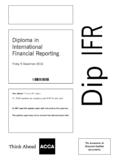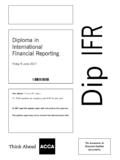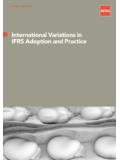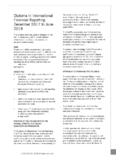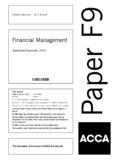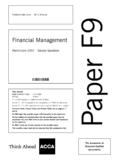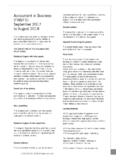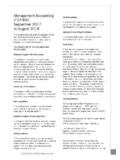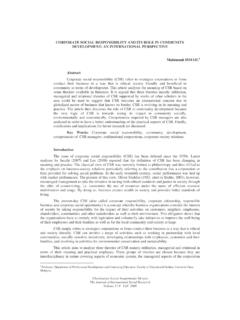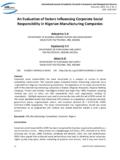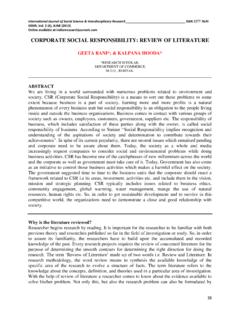Transcription of Examiner Report F9 March 2018 v2 - accaglobal.com
1 Examiner s reportF9 Financial ManagementMarch 2018 Examiner s Report F9 March 20181 General commentsThe F9 Financial Management exam is offered in both computer-based exam (CBE) and paper-based exam (PBE) formats. The structure is the same in both formats, but the CBE delivery modelmeans that candidates do not all receive the same set of questions. In this Report , the examiningteam share observations from the marking process, highlight strengths and weaknesses incandidates performance, and offer constructive advice for future candidates. Section A objective test questions we focus on two specific questions that causeddifficulty in this sitting of the exam.
2 Section B case-based objective test questions here we look at the key challenge areasfor this section in the exam. Section C constructed response questions - here we provide commentary around some ofthe main themes that have affected candidates performance in this section of the exam,identifying common knowledge gaps and offering guidance on where exam technique couldbe improved, including using CBE functionality in answering these in the March 2018 examination diet was fairly good and there were some goodindividual performances. Congratulations to those candidates who were successful in thisexamination diet. If you were not successful, we hope that you will study the content of this reportcarefully as part of your preparation for your next , there were again some candidates who were clearly underprepared for anexamination in Financial Management at this level.
3 It is worth emphasising once again thatcandidates sitting this examination must study the whole of the syllabus to prepare themselvesadequately for this assessment of Financial Management , candidates were well-prepared in some areas of the syllabus, particularly those that havefeatured regularly such as calculating WACC or NPV, but less well prepared in others. In addition,while candidates continued to be well prepared in techniques requiring calculation, they were lesswell-prepared in the requirements found in Section C for discussing knowledge and explainingterms and AThe objective test questions in Section A aim for a broad coverage of the F9 syllabus, hence allareas of the syllabus must be studied.
4 Candidates preparing for the F9 examination are thereforeadvised to work through as many practice objective test questions as possible, reviewing carefullyhow correct answers were derived in any areas where they have following questions are reviewed with the aim of giving future candidates an indication of thetypes of questions asked and guidance on dealing with such exam 1 is numerical and illustrates the importance of reading the question carefully andunderstanding the difference between an asset beta and an equity 2 is a question testing understanding of business s Report F9 March 20182 Example 1 Leah Co is an all equity financed company which wishes to appraise a project in a new area ofactivity.
5 Its existing equity beta is The industry average equity beta for the new business areais , with an average debt / debt + equity ratio of 25%. The risk-free rate of return is 5% and themarket risk premium is 4%.Ignoring tax and using the capital asset pricing model, calculate a suitable risk-adjustedcost of equity for the new this case, candidates should ignore the existing equity beta of and use the industry averageequity beta of This proxy beta needs to be ungeared. a= 2 x (75/100) = asset beta does not need to be CAPM, ke= 5 + x 4 = = 11%.Example 2 Alpha Co and Beta Co are two companies in different industries who are both evaluating theacquisition of the same target company called Gamma Co is in the same industry as Alpha Co has valued Gamma Co at $100m but Beta Co has only valued Gamma Co at $ of following statements would explain why Alpha Co's value of Gamma Co is higher?
6 AAlpha Co has used more prudent growth estimatesBBeta Co could achieve more synergyCBeta Co is a better negotiator than Alpha CoDGamma Co is a direct competitor of Alpha CoThe correct response is Alpha Co used more prudent growth estimates, this would reduce the value of Gamma Beta Co could achievemore synergy, this would increase the value that Beta Co has placed onthe skills will determine the final price paid for Gamma Co, not the initial s Report F9 March 20183By eliminating a competitor, there is synergy potential for Alpha meaning they would be preparedto pay more for Gamma than Beta would, therefore statement D is BSimilarly to Section A, questions can come from any area of the commentsCandidates should read the question carefully and follow the instructions on how to answer thequestion, for example if a question asks the candidate to select two correct statements, then markscan only be awarded if two statements have been selected.
7 There is no partial marking, so ananswer which only selects one statement will be awarded no marks. A candidate who selects threestatements will also receive no addition, when answering a number entry question, candidates must ensure they are enteringtheir answer in the correct format as stated in the that were noted under specific syllabus areas are as set out appraisalThere continue to be some common themes for errors made by some candidates on numericalinvestment appraisal questions. For example, some candidates do not identify correctly relevantcash flows for an investment project, or make mistakes with respect to the timing of future in a capital rationing questions, a number of candidates appear to have not consideredthe cash outflows in selecting their investment projects, instead only considering the cash candidates must read the question carefully to identify the correct timing of all project calculating the sensitivity of a NPV appraisal to sales volume.
8 All relevant cash flowsaffecting by a change in sales volume need to be considered by other area which caused difficulty for some candidates was selecting the appropriate discountrate to be used in a lease versus buy valuationOne common error was not excluding internally generated goodwill from an assets-based valuationof a error was from candidates who did not seem to know how to calculate a s Report F9 March 20184 Price earnings ratio questions caused difficulties for some candidates, one particular issue beingthe need to deduct preference dividends before applying a price earnings question which caused particular difficulty was one which required understanding of the Gordongrowth model and the dividend growth model and the inputs, showing that a number of studentsmay be happy to calculate using the formulae, but they do not have a full understanding of managementIt was common for candidates to make errors through lacking understanding of the features of riskmanagement derivatives.
9 This was from both a foreign exchange and an interest rate perspective,but particularly noticeable for questions on interest rate derivatives and especially interest rateoptions. This is a common area of difficulty noted across a number of recent sessions, so futurecandidates are encouraged to pay particular attention to this part of the questions on foreign exchange hedging it remains common to see errors occurring fromcandidates selecting the incorrect exchange rate and not time apportioning interest rates in amoney market hedge also struggled with a question requiring understanding of the causes of interestfluctuations and the underlying theories. Future candidates should be aware that they can betested on these theories listed in the study was one further area relating to interest rates which candidates struggled with which wasunderstanding of gap exposure and the significance of the types of gap for the management environmentA lack of understanding how a company could introduce measures to reduce stakeholder conflictand also what a company should do to maximise shareholder wealth led to errors for this part ofthe CThe main issue arising from candidates responses to Section C questions is that, in general.
10 Candidates perform much better on calculation-based questions than they do on discursive(discussion-based) is in section C of the examination that candidates have the opportunity to display deeperknowledge of topics. While there were many good or reasonable answers to most parts ofquestions, there were too many answers to discursive questions that displayed little or noknowledge of Financial Management. Discursive questions can be worth up to 10 marks and it isparticularly concerning that some candidates simply did not attempt is essential that question requirements are read carefully and that candidates directly addressthese requirements.

